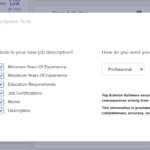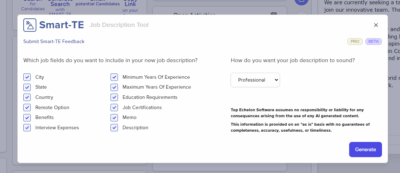The recruitment landscape has evolved dramatically over the past decade, driven by technological advancements and shifting workforce dynamics. For HR professionals, corporate recruiters, and hiring managers, effectively targeting job applicants has become a critical component of successful talent acquisition. HR recruiting software, also known as applicant tracking systems (ATS) or talent acquisition software, offers a suite of powerful features designed to streamline the recruitment process and enhance targeting strategies.
This article from Top Echelon Recruiting Software explores how to leverage the features of recruiting software to effectively target job applicants, from sourcing and engaging candidates to screening and evaluating them.
Understanding the Importance of Targeting in Recruitment
Targeting the right job applicants is essential for several reasons:
- Improved Quality of Hire: By focusing on candidates who possess the necessary skills, experience, and cultural fit, organizations can improve the quality of their hires.
- Reduced Time-to-Fill: Effective targeting reduces the time it takes to identify and hire suitable candidates, ensuring that positions are filled promptly.
- Cost Efficiency: Targeting helps allocate recruitment resources more efficiently, minimizing unnecessary expenditures on broad, untargeted recruitment campaigns.
- Enhanced Candidate Experience: Engaging with the right candidates from the start ensures a smoother recruitment process and a better candidate experience.
Key Features of Recruiting Software for Targeting Job Applicants
1. Job Posting and Distribution
Recruiting software simplifies the job posting process by allowing HR teams to create and distribute job listings across multiple platforms, including job boards, social media, and company career sites. This feature ensures that job openings reach a broader audience and are tailored to attract the right candidates.
Strategies for Effective Job Posting:
- Keyword Optimization: Use relevant keywords in job titles and descriptions to ensure that listings appear in search results of suitable candidates.
- Targeted Job Boards: Post job openings on niche job boards that cater to specific industries or roles to attract specialized talent.
- Social Media Integration: Leverage social media platforms to reach passive candidates who may not be actively searching on traditional job boards.
2. Candidate Sourcing
Advanced recruiting software includes tools for proactive candidate sourcing. These tools use AI and machine learning algorithms to search databases, social media, and other online platforms for potential candidates who match specific job criteria.
Strategies for Effective Candidate Sourcing:
- Boolean Searches: Use Boolean search techniques to refine candidate searches based on specific skills, experience, and qualifications.
- Social Media Mining: Utilize social media platforms like LinkedIn, GitHub, and industry-specific forums to identify and engage with passive candidates.
- Talent Pools: Build and maintain talent pools of pre-qualified candidates for future job openings, ensuring a quick response when new positions arise.
3. Resume Parsing and Screening
Resume parsing is the process of extracting relevant information from resumes and converting it into structured data. Recruiting software uses natural language processing (NLP) and AI to parse resumes quickly and accurately, enabling efficient screening of large volumes of applications.
Strategies for Effective Resume Parsing and Screening:
- Automated Screening: Set up automated screening criteria to filter out unqualified candidates and prioritize those who meet the job requirements.
- Customizable Filters: Use customizable filters to narrow down candidate lists based on specific skills, experience, and qualifications.
- Continuous Refinement: Continuously refine screening criteria based on feedback from hiring managers and evolving job requirements.
4. Candidate Relationship Management (CRM)
A candidate relationship management system helps HR teams build and maintain relationships with potential candidates. CRM features include communication tools, talent pools, and engagement analytics.
Strategies for Effective Candidate Relationship Management:
- Regular Communication: Maintain regular communication with potential candidates through personalized emails, newsletters, and updates about job openings.
- Engagement Tracking: Use engagement analytics to track candidate interactions and tailor communication strategies accordingly.
- Nurturing Campaigns: Implement nurturing campaigns to keep passive candidates engaged and interested in future opportunities.
5. Interview Scheduling and Management
Recruiting software streamlines the interview process by offering tools for scheduling, conducting, and evaluating interviews. Automated scheduling eliminates the back-and-forth of arranging interview times, while video interview capabilities allow for remote assessments.
Strategies for Effective Interview Scheduling and Management:
- Automated Scheduling: Use automated scheduling tools to coordinate interviews efficiently, reducing delays and ensuring a smooth process.
- Structured Interviews: Implement structured interview formats to ensure consistency and fairness in candidate evaluation.
- Collaborative Evaluation: Use collaborative evaluation tools to gather feedback from multiple interviewers and make informed hiring decisions.
6. Analytics and Reporting
Data-driven decision-making is a critical aspect of modern HR. Recruiting software provides robust analytics and reporting capabilities, offering insights into key metrics such as time-to-fill, cost-per-hire, and candidate quality.
Strategies for Effective Use of Analytics and Reporting:
- Performance Metrics: Track performance metrics to evaluate the effectiveness of recruitment strategies and make data-driven improvements.
- Source Effectiveness: Analyze the effectiveness of different sourcing channels to optimize resource allocation.
- Candidate Insights: Use candidate insights to understand trends and preferences, tailoring recruitment strategies accordingly.
7. Onboarding
The onboarding process is crucial for integrating new hires into the organization. Some recruiting software solutions include onboarding features that streamline paperwork, training, and orientation activities.
Strategies for Effective Onboarding:
- Preboarding Activities: Engage new hires before their start date with preboarding activities, such as welcome emails and introductory materials.
- Automated Workflows: Use automated workflows to streamline onboarding tasks and ensure a seamless transition for new hires.
- Feedback Collection: Collect feedback from new hires about their onboarding experience to make continuous improvements.
Implementing Recruiting Software to Target Job Applicants
1. Defining Your Target Audience
The first step in effectively targeting job applicants is to define your target audience. This involves understanding the specific skills, experience, and attributes required for the job, as well as the characteristics of the ideal candidate.
Steps to Define Your Target Audience:
- Job Analysis: Conduct a thorough job analysis to identify the key responsibilities, skills, and qualifications needed for the role.
- Candidate Persona: Create candidate personas that represent the ideal candidates for different roles. Include details such as career background, education, skills, and personal attributes.
- Market Research: Conduct market research to understand where your target candidates are most likely to be found, including preferred job boards, social media platforms, and professional networks.
2. Crafting Compelling Job Descriptions
A well-crafted job description is essential for attracting the right candidates. It should be clear, concise, and highlight the key responsibilities and requirements of the role, as well as the benefits of working for your organization.
Tips for Crafting Compelling Job Descriptions:
- Clear Titles: Use clear and specific job titles that accurately reflect the role.
- Engaging Language: Write in an engaging and conversational tone that appeals to potential candidates.
- Key Responsibilities: Clearly outline the key responsibilities and expectations of the role.
- Qualifications and Skills: List the essential qualifications and skills required for the job.
- Company Culture: Highlight your company culture and values to attract candidates who align with your organizational ethos.
- Benefits and Perks: Include information about benefits, perks, and career development opportunities to make the job more attractive.
3. Leveraging Technology for Targeted Recruitment
Recruiting software offers various technological tools to help target job applicants more effectively. Leveraging these tools can significantly enhance your recruitment efforts.
Strategies for Leveraging Technology:
- AI-Powered Sourcing: Use AI-powered sourcing tools to identify and engage with potential candidates who match your job criteria.
- Programmatic Advertising: Implement programmatic advertising to automatically place job ads in front of the right audience based on data-driven targeting.
- Social Media Recruiting: Utilize social media platforms to reach passive candidates and build your employer brand.
4. Personalizing Candidate Engagement
Personalized engagement is key to attracting and retaining top talent. Recruiting software can help personalize candidate interactions and create a more tailored experience.
Strategies for Personalizing Candidate Engagement:
- Tailored Communication: Use candidate data to tailor communication and provide relevant information based on their interests and career goals.
- Automated Follow-Ups: Set up automated follow-ups to keep candidates informed and engaged throughout the recruitment process.
- Candidate Experience Surveys: Collect feedback from candidates about their experience and use this data to make improvements.
5. Building and Maintaining Talent Pools
Building and maintaining talent pools is an effective way to ensure a steady flow of potential candidates for future job openings. Recruiting software provides tools to manage and nurture talent pools.
Strategies for Building and Maintaining Talent Pools:
- Segmented Talent Pools: Create segmented talent pools based on skills, experience, and job roles to facilitate targeted recruitment.
- Regular Updates: Keep talent pools updated with new candidates and ensure that existing candidates’ information is current.
- Engagement Campaigns: Run engagement campaigns to keep talent pool members informed about new opportunities and company news.
Measuring the Effectiveness of Targeting Strategies
To ensure that your targeting strategies are effective, it is important to measure and analyze their impact. Recruiting software provides various metrics and analytics to evaluate the success of your recruitment efforts.
Key Metrics to Track:
- Time-to-Fill: Measure the average time it takes to fill positions to identify bottlenecks in the recruitment process.
- Cost-per-Hire: Calculate the cost-per-hire to evaluate the efficiency and cost-effectiveness of your recruitment strategies.
- Source of Hire: Track the effectiveness of different sourcing channels to optimize resource allocation.
- Quality of Hire: Assess the performance and retention of new hires to determine the quality of candidates recruited.
- Candidate Experience: Collect feedback from candidates to gauge their satisfaction with the recruitment process and identify areas for improvement.
Case Studies: Successful Targeting with Recruiting Software
Case Study 1: Tech Company’s Targeted Sourcing Strategy
A mid-sized tech company was struggling to find qualified software developers. They implemented a recruiting software solution with AI-powered sourcing tools to identify potential candidates on social media and professional networks.
Results:
- Increased Candidate Pool: The company expanded its candidate pool by 40% by identifying passive candidates who were not actively looking for jobs.
- Reduced Time-to-Fill: The average time-to-fill for developer positions decreased from 60 days to 35 days.
- Improved Quality of Hire: The quality of hire improved significantly, with new developers meeting or exceeding performance expectations.
Case Study 2: Retail Chain’s Personalized Candidate Engagement
A large retail chain wanted to improve its candidate engagement to reduce high turnover rates. They implemented recruiting software with CRM capabilities to personalize communication and track candidate interactions.
Results:
- Enhanced Candidate Experience: Personalized engagement led to a 25% increase in candidate satisfaction scores.
- Reduced Turnover: Improved candidate engagement and onboarding processes reduced the 90-day turnover rate by 15%.
- Higher Offer Acceptance Rates: The offer acceptance rate increased by 20% due to better communication and candidate relationship management.
HR Recruiting Software: Embrace the Future
Recruiting software is an indispensable tool for HR professionals, corporate recruiters, and hiring managers aiming to effectively target job applicants. By leveraging features such as job posting and distribution, candidate sourcing, resume parsing and screening, candidate relationship management, interview scheduling, analytics and reporting, and onboarding, organizations can enhance their recruitment processes and achieve better hiring outcomes.
Implementing best practices and continuously measuring the effectiveness of targeting strategies ensures that recruitment efforts are efficient, cost-effective, and successful in attracting top talent. As technology continues to advance, staying abreast of new developments in recruiting software will be crucial for maintaining a competitive edge in talent acquisition.








